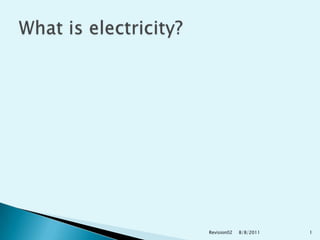E003B electrical concepts
•Download as PPTX, PDF•
1 like•6,664 views
The document discusses the basic concepts of electricity including voltage, current, resistance, and atoms. It explains that voltage is electrical pressure, current is the flow of electrons, and resistance opposes current flow. Atoms are made up of electrons, protons and neutrons. An atom can gain or lose electrons to become positively or negatively charged ions. Current is defined as the conventional flow of electrons from the negative terminal to the positive terminal of a battery when a conducting path is provided.
Report
Share
Report
Share

Recommended
Recommended
More Related Content
What's hot
What's hot (20)
Class-6th Science chapter-12 Electricity and Circuits part-1

Class-6th Science chapter-12 Electricity and Circuits part-1
Similar to E003B electrical concepts
Similar to E003B electrical concepts (20)
Chapter 1: Introduction to Principles of Electric and Electronics

Chapter 1: Introduction to Principles of Electric and Electronics
Engineering plant facilities 02 electricity fundamentals

Engineering plant facilities 02 electricity fundamentals
molecule-gas-atom-ionization-raising-h-to-136-electronvolts.pdf

molecule-gas-atom-ionization-raising-h-to-136-electronvolts.pdf
molecule-gas-atom-ionization-raising-h-to-136-electronvolts (1).pdf

molecule-gas-atom-ionization-raising-h-to-136-electronvolts (1).pdf
More from popet
More from popet (20)
Recently uploaded
https://app.box.com/s/7hlvjxjalkrik7fb082xx3jk7xd7liz3TỔNG ÔN TẬP THI VÀO LỚP 10 MÔN TIẾNG ANH NĂM HỌC 2023 - 2024 CÓ ĐÁP ÁN (NGỮ Â...

TỔNG ÔN TẬP THI VÀO LỚP 10 MÔN TIẾNG ANH NĂM HỌC 2023 - 2024 CÓ ĐÁP ÁN (NGỮ Â...Nguyen Thanh Tu Collection
Recently uploaded (20)
HMCS Max Bernays Pre-Deployment Brief (May 2024).pptx

HMCS Max Bernays Pre-Deployment Brief (May 2024).pptx
Python Notes for mca i year students osmania university.docx

Python Notes for mca i year students osmania university.docx
Basic Civil Engineering first year Notes- Chapter 4 Building.pptx

Basic Civil Engineering first year Notes- Chapter 4 Building.pptx
This PowerPoint helps students to consider the concept of infinity.

This PowerPoint helps students to consider the concept of infinity.
TỔNG ÔN TẬP THI VÀO LỚP 10 MÔN TIẾNG ANH NĂM HỌC 2023 - 2024 CÓ ĐÁP ÁN (NGỮ Â...

TỔNG ÔN TẬP THI VÀO LỚP 10 MÔN TIẾNG ANH NĂM HỌC 2023 - 2024 CÓ ĐÁP ÁN (NGỮ Â...
Interdisciplinary_Insights_Data_Collection_Methods.pptx

Interdisciplinary_Insights_Data_Collection_Methods.pptx
Micro-Scholarship, What it is, How can it help me.pdf

Micro-Scholarship, What it is, How can it help me.pdf
HMCS Vancouver Pre-Deployment Brief - May 2024 (Web Version).pptx

HMCS Vancouver Pre-Deployment Brief - May 2024 (Web Version).pptx
ICT Role in 21st Century Education & its Challenges.pptx

ICT Role in 21st Century Education & its Challenges.pptx
Salient Features of India constitution especially power and functions

Salient Features of India constitution especially power and functions
Fostering Friendships - Enhancing Social Bonds in the Classroom

Fostering Friendships - Enhancing Social Bonds in the Classroom
E003B electrical concepts
- 1. 8/9/2011 Revision02 1 What is electricity?
- 2. Voltage: electrical pressure Current: flow of negative charges Resistance: opposition to current flow 8/9/2011 Revision02 2 There are three basic properties of an electrical circuit:-
- 3. VOLTAGE is electrical pressure CURRENT is a flow of electrons and occurs only if there is a voltage and a path for the electrons. 8/9/2011 Revision02 3
- 4. Resistance RESISTANCE is opposition to current flow. A conductor has a low resistance; an insulator has a high resistance. 8/9/2011 Revision02 4
- 5. 8/9/2011 Revision02 5 The Atom
- 6. ATOMS Electrons in energy levels The same number of Electrons as Protons No electrical charge 8/9/2011 Revision02 6
- 7. In electrical studies the nucleus remains the same, no protons are added or lost. The nucleus charge is never changed. An atom will only gain or lose an electron or electrons. This gain or loss will be in the outer shell. Valency shell If an atom has a charge it becomes an ION 8/9/2011 Revision02 7 ATOMS
- 8. Like charges repel Unlike charges attract The electrons are pushed from one object and pulled to the other object. This push/pull or force is called an emf (voltage). Units Volts, Symbol V (E) By the way, the effective speed of the electron flow is 7.5 times around the world in 1 second 8/9/2011 Revision02 8 Remember
- 11. (+) ION The ion has lost an electron The total electrical charge is (+) 8/9/2011 Revision02 11
- 12. (-) ION This ion has gained an electron The total electrical charge is (-) 8/9/2011 Revision02 12
- 13. If the terminals have an external conducting path, the battery will continue to take electrons from the (+) terminal and place them on the (-) terminal. The thing to understand is: Electrons are NOT created or destroyed. They simply flow around the conducting path (circuit). 8/9/2011 Revision02 13 WHEN A SOURCE(battery) IS ADDED
- 14. ELECTRON FLOW When a conducting path is added the additional electrons will move to the free spaces (holes) where electrons are missing 8/9/2011 Revision02 14
- 15. The electrons flow from (-) to (+). ELECTRON FLOW The flow of electrons is called CURRENT. CONVENTIONAL CURRENT Flow is (+) to (-). Conventional Current flow is the Australian Standard. The unit of measurement is the ampere we use Amps The symbol is A 8/9/2011 Revision02 15 Current
- 16. 8/9/2011 Revision02 16 Resistance A circuit must have an opposition to electron flow. Or the very high current would cause major problems. This opposition is called RESISTANCE. Measuring Unit - Ohm Symbol - W
- 17. The voltage is 240 volts. V = 240V The current is 10 amperes I = 10A The resistance is 200 ohms R = 200W 8/9/2011 Revision02 17 Examples